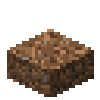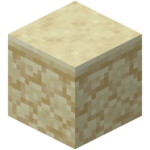Slabs
| This page contains content copied from the v1.5.2 VMC Wiki This page still requires a cleanup pass that integrates the changes from BTW to be considered correct and complete |
|
Type |
Solid Block |
|
Stackable |
Yes (64), same type only |
|
Tool |
wooden pickaxe |
|
Gravity |
No |
|
Luminance |
No |
|
Stone: No |
Slabs are half-blocks. Upside-down slabs occupy the top half of their block space rather than the bottom half. To place a slab upside-down, right-click on the bottom of a "ceiling" block, which can be removed after the slab has been placed, or by right clicking the top half of another block, if the player wishes to place it on the side of another double or single slab block.
All types of "stone" slab have the same data values; like wood and colored wool, they are differentiated by their damage values: stone slabs have a damage value of 0, sandstone slabs has 1, old wooden slabs has 2 (which were actually stone, and are still obtainable), cobblestone slabs has 3, bricks has 4, stone bricks has 5, and nether bricks has 6. Damage value 7 is occupied by nether quartz, and formerly by a smooth variant of the stone slab. Upside down stone slabs have a damage value of 8, sandstone has 9, wooden has 10, cobblestone has 11, bricks has 12, stone bricks has 13, nether bricks has 14, and nether quartz has 15. Real wood slabs use a different set of block and damage values.
Contents
Occurrence
Stone slabs can be found naturally in NPC Villages lining the roof of a blacksmith shop and inside some of the buildings where they form counters. They are also found in Strongholds where they are used in some of the stairs, ledges and torch pillars. Sandstone slabs can be found naturally in desert wells and desert temples.
Crafting
Unlike many wooden items, wooden slabs must be crafted entirely from one type of wood, but by the same token, they keep the type (and color) of the wood used, thus "Birch Wood Slabs" and so forth.
| Ingredients | Input » Output | |||||||||||
|---|---|---|---|---|---|---|---|---|---|---|---|---|
| Stone, Sandstone, Cobblestone, Bricks, Stone Brick, Wood Planks, Nether Brick, or Block of Quartz |
|
As a crafting ingredient
| Ingredients | Input » Output | |||||||||||
|---|---|---|---|---|---|---|---|---|---|---|---|---|
| Sandstone Slabs or Quartz Slabs |
| |||||||||||
| Glass + Nether Quartz + Wooden Slabs |
|
Behavior
Like other partial blocks slabs are treated as a whole block by other blocks, such as dirt, stone, and glass, and liquids. Two slabs of the same type (e.g. two stone slabs) can be placed one on top of one another to make a single full-size block, but different slab types cannot be mixed in this way. Sandstone, wooden, and cobblestone double-slabs look exactly the same as their full block counter-parts, but take a longer time to break and drop two slabs. Wooden slabs are collected more quickly with an axe and are flammable.
Single slabs have the tendency to let through arrows shot from above. They will also destroy gravel and sand blocks that fall onto them (the same as torches, as long as the slab is a bottom-half). They are also treated as transparent by the game and can cause suffocation, prevent placement of torches or other fixtures on them and chests with single slabs above them can still be opened.
An unusual property of slabs is that they are non-solid to redstone. This allows redstone wiring to be hidden underneath while still being able to connect to the wire on the side of the slabs.
Mobs can spawn on top of upside down slabs and on double slabs.
Due to the way blast rays propagate from an explosion slabs provide extremely effective absorption to explosions directly on top of them. Specifically, this is because explosive entities will be lower in elevation when they explode on top of slabs than they would otherwise be on an ordinary block. Although the few slab(s) directly under the explosion will absorb the full force of the blast (with a resistance of 30) as usual, the propagation of damage to the sides will be greatly reduced. If source of the explosion is elevated for any reason at the time of the blast, this protective quirk is lost.
Despite how sneaking lowers the player's eye level half a block, doing so does not allow the player to walk over a single slab with one block of air above it because of the player's true height. A player cannot walk from a block of soul sand to a slab without jumping.
Video
History
Template:History Template:History Template:History Template:History Template:History Template:History Template:History Template:History Template:History Template:History Template:History Template:History Template:History Template:History Template:History Template:History Template:History Template:History
Dirt slab

Before stone slabs were added to 0.26, Notch ran a test of dirt slabs. They were never added to the actual game and were only mentioned once.<ref>wordofnotch:220243988/half-sized-blocks-all-dirt-tiles-so-it-kinda</ref> They replaced all dirt blocks and did not grow grass on top.
Issues
Trivia
- An unused slab type, known as the "smooth full half-slab", has a data value of 437, but can only be obtained with Template:Cmd or an inventory editor. It is a full block with the top texture of stone slabs on all six sides. As of Template:Verlink, the data value is 438 and a similar effect with sandstone can be obtained with 439. See the gallery for a comparison image.
- Before version 13w05a stairs prevented sprinting. Since slabs did not they were used in place of stairs. They were also used to keep floors from catching on fire.
- In the Pocket Edition, wooden slabs are treated as stone slabs and must be mined with a pickaxe. This characteristic of slabs existed in outdated versions of Minecraft PC.
- Since the Beta light update, slabs now let a small amount of light pass through their edges. This light is only visible with Smooth Lighting turned on, and does not affect mob spawning or other light-dependent processes.
- The exception of this is that any light directed through a slab does not affect any block's light values north of the source.
- When a slab is placed on top of ice, the slab has the same "slipperiness" as the ice below it. This applies to every other block with a hit-box that is lesser than a full block.
- If slabs are placed below TNT, it will significantly reduce their damage. By making a floor of slabs, the TNT will lower its explosive power to two blocks instead of six. This is so because the TNT believes that it is inside the slab, for the game thinks that it is inside a full block, greatly reducing its explosion radius.
- Stone slabs are the only slab which, when stacked, do not mimic their block in texture.
- You can sneak walk off slabs at ground level.
- Minecarts on powered rails will not be repelled from a slab. They will, however, be repelled by a slab with a minecart on top.
- Though the new wooden slabs are flammable, the old wooden oak/"stone" slab is still available through inventory editing or the /give command, so in a world/server where commands are allowed, it is still possible to obtain fireproof wooden slabs.
- When Creepers explode on stone slabs they only destroy the slab they were standing on and nothing else in the area.
- It is possible to get any type of double slab that you want by using the /give command and typing in /give (player) 43 1 (slab id). This will allow you to build faster.
- If you type in /give <player> 43 1 10, then it will give you a wooden plank, but it acts like a stone block. It is not flammable and it makes "stone" sound effects when they are placed, broken, or stepped on.
- If redstone dust is placed on an upside-down slab, it will not trigger adjacent TNT.
Gallery
- Brick Slabz.png
Brick slabs.
- Stone Brick Slabz.png
Stone Brick slabs.
- Newstoneslab.png
Double stone slab (left) compared to smooth full half-slab.
- Tavern StoneSlabs.png
Naturally occurring stone slabs in a butcher shop.
- Smithy Stone Slab.png
Naturally occurring stone slabs in a village Blacksmith.
- QVA1C.png
First image of upside down slabs as shown on Jeb's Twitter.
- UpperHalfSlabs.png
Slabs used to create the impression of half-aligned full blocks.
- Tipe.png
All four types of wooden slabs.
- HalfTrapSlabDoors.png
Trap doors on slabs.
- 2012-01-27 16.16.57.png
Example of slab shelving by placing slabs below other slabs.
- Smooth Sandstone Slab comparison.png
Smooth sandstone double slabs (439) compared to smooth stone double slabs (438).
References
<references/>


